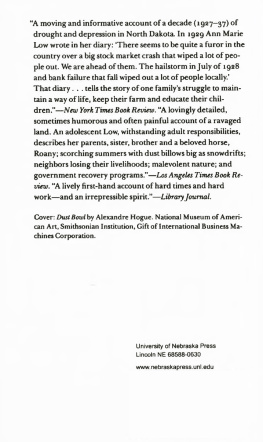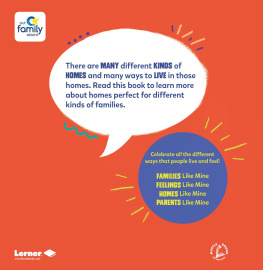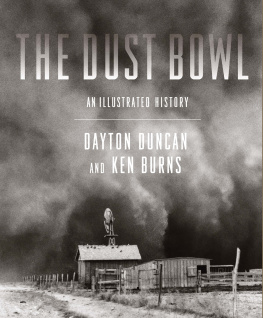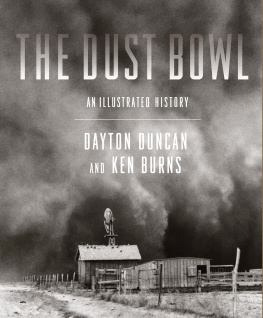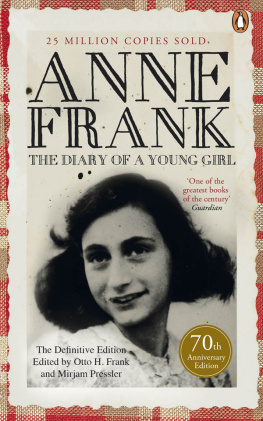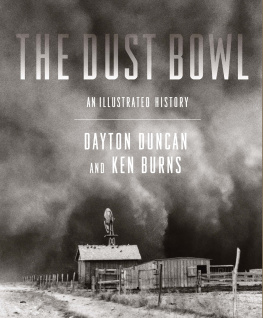Copyright 1984 the University of Nebraska Press
All Rights Reserved
Library of Congress Cataloging in Publication Data
Low, Ann Marie, 1912
Dust bowl diary.
1. Low, Ann Marie, 1912
2. North Dakota Biography.
3. Farm Life North Dakota
History 20th century.
4. North Dakota Social
conditions. 5. North Dakota
Economic conditions.
6. Depressions 1929
United States. I. Title.
F636.L92 1984
978.40320924 84-3672
ISBN-13: 978-0-8032-7913-1 (paper: alk. paper)
ISBN-13: 978-0-8032-8065-6 (electronic: e-pub)
ISBN-13: 978-0-8032-8066-3 (electronic: mobi)
The publisher does not have any control over and does not assume any responsibility for author or third-party websites or their content.
Dedicated to
Bennie Woolley, Creative Writing Instructor at Yavapai College, and to Bernice Brown and
Dorothy L. Murphy, freelance writers in Sedona, Arizona, for their help and encouragement
Preface
Talk about wind! Most of the scenery is in the air. These words hit my eyes as I opened my fifty-year-old diary that I found while rummaging in a trunk. The words brought it all back: the Dust Bowl years; the loss of the Stony Brook countrya loss still a heartache after all these years. My old diary tells the story of that period of history, and what it did to my family, from my point of view, that of a woman who lived it. Our family consisted of my father and mother me, my younger sister, Ethel, and brother Bud, the youngest, living on a large stock farm in southeastern North Dakota. My fathers mother and his two brothers, Grover and Ted, much younger than he, lived on the old family homestead two and a half miles away.
This book is based upon the diary I kept between 1927 and 1937. Much of it, of no interest beyond my immediate family, has been omitted. The only additions are a few details not included in my diary but written at that time in letters to my fathers sister Evalyn. She kept some of my letters, which were returned to me after her death. I have added narrative material to fill in gaps in the story. When the diary and the narrative were put together, it became apparent that I had two stories to tell: the account of the effect of the drouth, depression, and government programs upon my family and neighbors, and the story of my own coming to maturity under frustrating family circumstances, hampered by the restrictions society at that time placed upon young women, and in the face of poverty, seeing all we had worked for slip away.
The place names are factual. Nearly all names of the people mentioned have been changed with the exception of mine, my husbands, and those of my parents, Mr. and Mrs. H. A. Riebe; the members of the Ferguson family; my fathers brothers and sisters; and those three notable old-timers, Bill Follis, Archie McKecknie, and Ben Bird.
PROLOGUE
The Breeze
My diary starts in 1927, the last of the good years before the Great Depression. From 1900 until the 1920s there had been prosperity in North Dakota. Land worth about ten dollars an acre in 1900 was worth thirty-five dollars in 1920. After World War I, prices dropped and farmers were left in debt for expansion during the war and were faced with high taxes and high prices for goods they had to buy.
Dad hated and avoided debt. Through 1927 he continued to prosper. My diary records that when he came back from St. Paul that autumn after selling his cattle, he brought back expensive presents for his children and a sealskin coat and black silk dress for Mama. The diary also says, I think a pink silk dress would be pretty on her, or a soft green to bring out the green in her eyes. Here all women past forty wear black dresses for best. When I get to be forty Ill wear a pink dress if I want to and never mind if the neighbors think I am trying to be young and frivolous.
Ethel and I were sophomores in high school that year and Bud was in the seventh grade. Previously we had attended a one-room rural school of all eight grades only a mile and a half from home. We walked to it or drove a horse and buggy or horse and sleigh. After I finished the eighth grade, Dad and Mama had me wait until Ethel finished and I was old enough to get a permit to drive a car. Then I drove Ethel, Bud, and myself to the town school seven miles away. When winter weather and roads prohibited driving, Dad hired a man named John to help do the farm work and his wife, Theresa, to keep house while Mama rented rooms in town and stayed there with us during the winter.
One day that fall, before we moved to town, I wrote in my diary,
Dad decided not to hire a man for shocking this year, so he and Bud and I shocked all the grain. With Bud and me in school, he has had to hire a man for fall plowing, a young fellow named Bill from Oklahoma he found bumming around town. Bill came up for harvest work, lost all his money in a crap game, and needs to earn some to get home. He is not much good with horses but is crazy to ride my Pronto. I wont let him. She was abused by a man before I got her. With time and patience I taught her to trust me. To this day, when a man goes near her, she tries to kick him into Kingdom Come .
Today I heard a commotion in the barn and rushed out to see what was going on. Pronto was standing in her stall looking half asleep. Bill was lying on the other side of the barn beneath my saddle and saddle blanket, looking as surprised as a dog with his first porcupine .
Bill! What have you done?
What have I done? Thats what I hate about two-facedness. To look at that horse youd think I did all this myself .
Tonight, after the chores were done, I rode Pronto out into the hills. How I love these hills, especially at sunset!
CHAPTER 1
The Hail Storm
By April of 1928 the roads were passable enough for Mama, Bud, Ethel, and me to get home from town on weekends.
April 30, 1928
Saturday we baked, washed, ironed, scrubbed floors, churned, and painted the kitchen. In the late afternoon I rode to the lake to see Grover, who was seeding his land up there, went one round with him, and then had to come home to milk cows. The thought now filters into my dim brain that I should never have learned to milk. Mama and Ethel never did .
Mama, unlike most farm women, never learned to milk and did very little outside work. Neither did Ethel. When she was eight years old the local doctor told Dad and Mama she had a heart murmur. Dad and Mama, frightened lest they lose Ethel, took very good care of her. Long before 1928 it was obvious that Ethel was physically capable of almost anything she wanted to do, but by that time the pattern in our family was set.
For a number of years, before we needed cream to sell, all we had was one family milk cow. The men hated to milk cows. When Bud was about nine years old, and I about twelve, a hired man taught us to milk. We had no dairy cows then and just milked a few range cows who gave more milk than the average range cow. They could run like deer and kick a cat off a fence post without touching the post. Rounding up those cows twice a day and getting them milked furnished all the excitement and adventure our young souls craved. By 1928 the cows were tamer and furnished less of our entertainment, but most of our amusements still had to be free.
Grover told me that once when he and his hired man, Willie, were getting a load of hay, Willie killed twenty mice at the stack and took them home to feed the cats. He fed them several that evening and put the rest in a bucket to dole out a few at a time. Before morning the cats got into the bucket and ate all the mice. Willie was heartbroken; his fun was spoiled.

